The Evolution of the Photographic Posture: Part Two
Further technological development liberated cameras from big and heavy tripods. Decreasing camera dimensions and therefore less weight and new flexible film suddenly made photographers move quick and responsive to the ever changing now.
With the introduction of roll film in 1881, fast carrying on of film between two or more single shots became a blissful reality – something which took before quiet some time and skill with large format film. Shooting 8, 12, 16 or more photographs in sequence (depending on the roll film length, camera model and therefore variable form factor for the exposure being used), was solved brilliantly with the new mechanical approach of using spools. Within the camera housing or film back one side is loaded with a fresh spool of roll film and on the other side a second identical take up spool is awaiting the exposed film to be rolled up — shot after shot. A paper backing for light protection at the beginning and end of the film roll allowed it to be conveniently changed in daylight too. What difference it made to the photographers workflow.
In 1928 German company Franke and Heidecke presented the Rolleiflex to the world, an overly popular high end twin lens reflex camera, and set the starting point for some excellent medium format cameras to follow such as the Japanese Mamiya 645 and RB67, Asahi Pentax 645 and 67, or the Swedish Hasselblad 1600F just to name a few. In the year of 1948 Hasselblad was featuring with the 1600F a first-ever modular camera design with interchangeable parts (like different view finders, winding mechanisms, film backs, etc.). Henceforward during shootings the photographer had the great advantage to easily switch between magazines loaded with variably kinds of films (like for example higher or lower sensitivity, colour or black/white, etc.).
Documentary, fine-art, street and fashion photography benefited immensely from the enhanced usability and flexibility of the new camera models if not to say even depended on their implementation. Photographers and artists like Richard Avedon or Cindy Sherman have used roll film quiet a lot for their creative work.
But there is another reason why Hasselblad cameras became so famous too: In 1969 astronauts of the Apollo Space missions landed for the very first time on the moon and took photographs with a Hasselblad Lunar Module Pilot Camera (an adapted Hasselblad 500EL). Those photographs were spread through all international news channels around the globe and made the Swedish company known worldwide over night. From 16 Hasselblads taken outer space during the NASA-missions allegedly only one was brought back to earth. It was auctioned to Mr. Terukazu Fujisawa, founder of Yodobashi Camera Japan, for € 660,000 (~$ 910,000) at the WestLicht Camera Auction in Vienna, March 2014.

“Apollo12Visor” by NASA/Charles Conrad – photograph taken with a Hasselblad lunar
One shared characteristic of cameras like Rolleiflex, Mamiya 645 or Hasselblad 1000F is their bright waist-level finder featuring a reversed image projection. It supports the process of composition but is challenging while tracking fast moving objects. Besides that taking photographs with a waist-level finder is sensed as not so much intrusive and less intimidating mainly because of the photographer not starring at the subject directly.
A photographer resting a camera with both hands in front of his or her belly, the head a little bit tilted forward and looking straight down is maybe the most representative photographic stance of the 1950s till 1980s. During that period manufacturers also began to offer less expensive cameras aimed for the mass market. Now, the former closed world of professional photographers only started to open up to amateurs and less technical versed people. It also was the dawn of snapshot photography.




